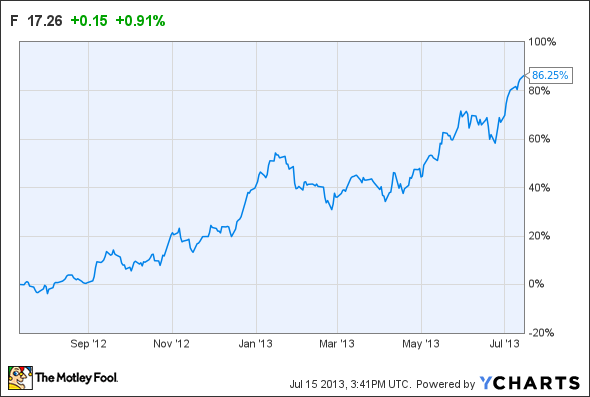
Ford Headquarters. Photo Courtesy of Ford Motor Company (NYSE:F).
I’ve been a Ford Motor Company (NYSE:F) supporter since Alan Mulally took over as CEO in 2006. Ford Motor Company (NYSE:F)’s been one of my most profitable investments, and one of the most intriguing business turnarounds to follow in decades. I’m a long-term investor so the short-term speed bumps that the company’s stock will hit don’t matter as much to me, but for those whose focus is only a few months it could be a bumpy ride.
Early bird gets the worm
One of the first issues that could cause a sell-off of Ford Motor Company (NYSE:F) stock is people simply taking profits. Take a look at the graph below to see how far Ford’s share price has surged this past year:

Ford Motor Company (NYSE:F)’s 52-week range is between $8.82 and $17.25, and those who bought exactly a year ago have realized an 86% increase at the time of this writing. That’s a healthy gain. In such a volatile industry where a company’s stock can tank, regardless of how well it’s performing, because of outside economic factors, such a gain could tempt people to take their profits now. In a market where the early seller typically gets the largest profit, it can make for a vicious cycle as people run to the exit.
If Ford continues its trek toward $18 it’s very possible we will see resistance in the share price as people begin to take profits from Ford’s nice one-year run-up. But, there are some short-term catalysts that will help mitigate that selling pressure.
The first positive catalyst would be short-term traders buying in before Ford Motor Company (NYSE:F)’s second-quarter earnings report on July 24 because they expect Ford to beat Wall Street estimates and give the stock a small boost. I think it’s a good bet in my book because it’s been a very strong first half of the year for Ford in the U.S. market. Ford Motor Company (NYSE:F) has gained market share in an industry seeing lowering incentives and higher transaction prices. In addition to that, the rebound in U.S. sales has been led by the most profitable full-size-truck segment – where Ford derives most of its profits. For those reasons we can expect a strong report and operating margins to again exceed 10%-11% – favorable to competitor General Motors Company (NYSE:GM) who reported a 6.2% operating margin last quarter.
If Ford does indeed beat Wall Street estimates and the stock jumps slightly, excitement tends to taper off a few days after the announcement and can often lead to a small pull back or correction. In this case, it could again be mitigated by another positive catalyst found in Ford’s ex-dividend date of July 31, which is the deadline that investors must own Ford stock by if they want to get paid the most recently announced dividend amount.
Bottom line
The volatility of a stock like Ford Motor Company (NYSE:F) is something long-term investors get used to as Wall Street and short-term investors focus on the next three months rather than the next three years. After the bumpy road of events takes place and the dust settles, long-term investors can take a step back and realize that the major factors of owning the stock remain unchanged and largely positive. Long-term investors who own the stock because of its industry-leading management, efficient operations, and potential growth in emerging markets still have great upside to realize in the years to come and short-term volatility won’t change that. This is just a friendly reminder that no matter what happens with Ford stock price over the next two to three weeks, it’s still a great company to own with tons of upside remaining.
The article Ford May Have a Short-Term Bumpy Ride originally appeared on Fool.com and is written by Daniel Miller.
Fool contributor Daniel Miller owns shares of Ford and General Motors. The Motley Fool recommends Ford and General Motors. The Motley Fool owns shares of Ford.
Copyright © 1995 – 2013 The Motley Fool, LLC. All rights reserved. The Motley Fool has a disclosure policy.




